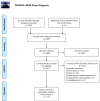Effects of Vitamin D Supplementation During Pregnancy on Birth Size: A Systematic Review and Meta-Analysis of Randomized Controlled Trials
- PMID: 30791641
- PMCID: PMC6412248
- DOI: 10.3390/nu11020442
Effects of Vitamin D Supplementation During Pregnancy on Birth Size: A Systematic Review and Meta-Analysis of Randomized Controlled Trials
Abstract
During pregnancy, vitamin D supplementation may be a feasible strategy to help prevent low birthweight (LBW) and small for gestational age (SGA) births. However, evidence from randomized controlled trials (RCTs) is inconclusive, probably due to heterogeneity in study design and type of intervention. A systematic literature search in the PubMed-Medline, EMBASE, and Cochrane Central Register of Controlled Trials databases was carried out to evaluate the effects of oral vitamin D supplementation during pregnancy on birthweight, birth length, head circumference, LBW, and SGA. The fixed-effects or random-effects models were used to calculate mean difference (MD), risk ratio (RR), and 95% Confidence Interval (CI). On a total of 13 RCTs, maternal vitamin D supplementation had a positive effect on birthweight (12 RCTs; MD = 103.17 g, 95% CI 62.29⁻144.04 g), length (6 RCTs; MD = 0.22 cm, 95% CI 0.11⁻0.33 cm), and head circumference (6 RCTs; MD:0.19 cm, 95% CI 0.13⁻0.24 cm). In line with these findings, we also demonstrated that maternal vitamin D supplementation reduced the risk of LBW (3 RCTs; RR = 0.40, 95% CI 0.22⁻0.74) and SGA (5 RCTS; RR = 0.69, 95% CI 0.51⁻0.92). The present systematic review and meta-analysis confirmed the well-established effect of maternal vitamin D supplementation on birth size. However, further research is required to better define risks and benefits associated with such interventions and the potential implications for public health.
Keywords: birth length; birthweight; diet; gestational age; head circumference; nutrition; pregnancy outcomes; vitamin D.
Conflict of interest statement
The authors declare no conflict of interest.
Figures








Similar articles
-
Association Between Vitamin D Supplementation During Pregnancy and Offspring Growth, Morbidity, and Mortality: A Systematic Review and Meta-analysis.JAMA Pediatr. 2018 Jul 1;172(7):635-645. doi: 10.1001/jamapediatrics.2018.0302. JAMA Pediatr. 2018. PMID: 29813153 Free PMC article.
-
Vitamin D Supplementation during Pregnancy: An Evidence Analysis Center Systematic Review and Meta-Analysis.J Acad Nutr Diet. 2020 May;120(5):898-924.e4. doi: 10.1016/j.jand.2019.07.002. Epub 2019 Oct 25. J Acad Nutr Diet. 2020. PMID: 31669079
-
Effect of balanced protein-energy supplementation given to pregnant women on birth outcomes: A systematic review and meta-analysis.Womens Health (Lond). 2025 Jan-Dec;21:17455057251335366. doi: 10.1177/17455057251335366. Epub 2025 Apr 30. Womens Health (Lond). 2025. PMID: 40305487 Free PMC article.
-
The Effects of Vitamin D Supplementation During Pregnancy on Maternal, Neonatal, and Infant Health: A Systematic Review and Meta-analysis.Nutr Rev. 2025 Mar 1;83(3):e892-e903. doi: 10.1093/nutrit/nuae065. Nutr Rev. 2025. PMID: 38950419 Free PMC article.
-
Effects of vitamin D supplementation during pregnancy on offspring health at birth: A meta-analysis of randomized controlled trails.Clin Nutr. 2022 Jul;41(7):1532-1540. doi: 10.1016/j.clnu.2022.05.011. Epub 2022 May 17. Clin Nutr. 2022. PMID: 35667269
Cited by
-
Calcifediol (25OHD) Deficiency and Its Treatment in Women's Health and Fertility.Nutrients. 2022 Apr 27;14(9):1820. doi: 10.3390/nu14091820. Nutrients. 2022. PMID: 35565788 Free PMC article. Review.
-
Vitamin D Deficiency, Excessive Gestational Weight Gain, and Oxidative Stress Predict Small for Gestational Age Newborns Using an Artificial Neural Network Model.Antioxidants (Basel). 2022 Mar 17;11(3):574. doi: 10.3390/antiox11030574. Antioxidants (Basel). 2022. PMID: 35326224 Free PMC article.
-
Vitamin D Supply of Twins during Fetal Life, Its Relation to Anthropometric Parameters of Newborns and the Analysis of Other Factors Related to Birth Size.Nutrients. 2024 Oct 18;16(20):3535. doi: 10.3390/nu16203535. Nutrients. 2024. PMID: 39458529 Free PMC article.
-
Associations between Longitudinal Maternal and Cord Blood Vitamin D Status and Child Growth Trajectories Up to 4 Years of Age.Nutrients. 2024 Jul 25;16(15):2410. doi: 10.3390/nu16152410. Nutrients. 2024. PMID: 39125291 Free PMC article.
-
Dietary Supplementation Before, During and After Pregnancy: Results of the Cluster-Randomized GeliS Study.Geburtshilfe Frauenheilkd. 2022 May 16;82(7):736-746. doi: 10.1055/a-1771-6368. eCollection 2022 Jul. Geburtshilfe Frauenheilkd. 2022. PMID: 35815097 Free PMC article.
References
-
- Pérez-López F.R., Pasupuleti V., Mezones-Holguin E., Benites-Zapata V.A., Thota P., Deshpande A., Hernandez A.V. Effect of vitamin D supplementation during pregnancy on maternal and neonatal outcomes: A systematic review and meta-analysis of randomized controlled trials. Fertil. Steril. 2015;103:1278–1288. doi: 10.1016/j.fertnstert.2015.02.019. - DOI - PubMed
Publication types
MeSH terms
Substances
LinkOut - more resources
Full Text Sources
Medical

